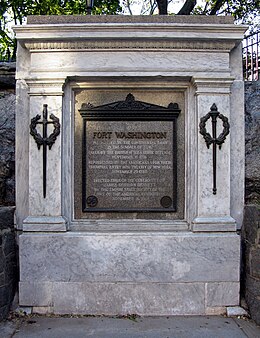Battle of Fort Washington
The Battle of Fort Washington was fought in New York on November 16, 1776, during the American Revolutionary War between the United States and Great Britain.
It was a British victory that gained the surrender of the remnant of the garrison of Fort Washington near the north end of Manhattan.
Colonel Robert Magaw, acting commander of the fort, refused to abandon it, believing his troops would be able to defend it from the British.
[10] Later in June, the Commander-in-Chief of the Continental Army, George Washington, inspected the location and determined that the area was the key to defense of the lower Hudson.
Shortly after Washington's survey, troops from Pennsylvania began construction on the fort under the supervision of Rufus Putnam.
After the barracks were finished in September, all the troops in the area were placed under the command of Major General William Heath.
[13] Batteries were placed on Jeffrey's Hook, which extended into the Hudson; on Cox's Hill looking over Spuyten Duyvil Creek; at the north end of Manhattan controlling the King's Bridge and Dyckman's Bridge over the Harlem River; and along Laurel Hill, located to the east of the Fort and along the Harlem River (see also Fort Tryon Park).
His northward progress was checked the next day in the Battle of Harlem Heights, after which he sought to flank the strong U.S. position on the north of the island.
[15] He left a garrison of 1,200 men at Fort Washington under the command of Colonel Robert Magaw,[16] although this force was inadequate to fully defend the extensive works in hindsight.
[18] On the morning of October 27, sentries informed Magaw that Percy's troops were launching an attack supported by two frigates sailing up the Hudson.
The Hessians held higher ground with better cover and had the advantage of artillery support throughout this minor skirmish, but were still unable to maintain their position.
On November 2, Magaw's adjutant, William Demont, deserted and supplied British command with detailed plans of the fortifications.
Greene argued that holding the fort would keep open communications across the river and might dissuade the British from attacking New Jersey.
Rather than pursue the U.S. forces in the highlands, and possibly prompted by the intelligence acquired by the defection of Demont, Howe had decided to attack Fort Washington.
[25] Seven thousand troops were to remain east of the Hudson under the command of Charles Lee to prevent a British invasion of New England; General William Heath with 3,000 men was to guard the Hudson Highlands to prevent any further British advance north, and Washington with 2,000 men was to go to Fort Lee.
[25] Howe's plan of attack was to storm the fort from three directions while a fourth force feinted; by then it had received reinforcements and was garrisoned by 3,000 men.
[24] Hessian troops under the command of Wilhelm von Knyphausen would attack the fort from the north, Percy was to lead a brigade of Hessians and several British battalions from the south, and Lord Cornwallis with the 33rd Regiment of Foot and General Edward Mathew with the light infantry were to attack from the east.
[27] Before attacking, Howe sent Lieutenant Colonel James Patterson under a flag of truce on November 15 to deliver a message that if the fort did not surrender, the entire garrison would be killed.
[32] The British troops charged up the hillside and dispersed the Americans until they reached a redoubt defended by some Pennsylvania Volunteer companies.
[33] To the north of the fort, the Hessian right, commanded by Johann Rall, moved up the steep hillside south of Spuyten Duyvil Creek against almost no resistance from the Americans.
[33] The Hessians crossed swampy land and when they approached the wooded hillside near the fort, they were fired upon by 250 riflemen of the Maryland and Virginia Rifle Regiment under the command of Lt. Col. Moses Rawlings.
[35] Margaret Corbin had been with her husband on the battlefield the entire time, and, after witnessing his death, she immediately took his place at the cannon, continuing to fire until she was wounded in her arm, chest, and jaw, thereby becoming the first known woman combatant in the American Revolution.
Graydon's superior was Lambert Cadwalader, Magaw's second in command, who was in charge of holding the three defensive lines south of Fort Washington.
[40] By this time, the riflemen's fire had almost ceased, and the Hessians slowly advanced up the hill and engaged the Americans in hand-to-hand fighting.
Overpowering the Americans, the Hessians reached the top of the hill and swarmed into the redoubt with a bayonet charge, capturing it quickly.
[41] Washington, who was watching the battle from the other side of the river, sent a note to Magaw asking him to hold out until nightfall, thinking that the troops could be evacuated during the night.
Rall sent Captain Hohenstein, who spoke English and French, under a flag of truce to call for the fort's surrender.
As they left the fort, the Hessians stripped the American troops of their baggage[4] and beat some of them, forcing their officers to intervene to prevent further injuries or deaths.
After about one month, on the night of December 25–26, 1776, Washington crossed the Delaware and defeated the Hessian garrison under the command of Rall at Trenton.




